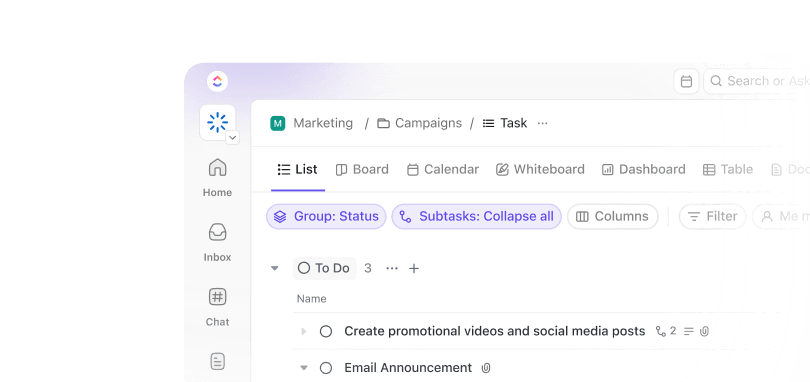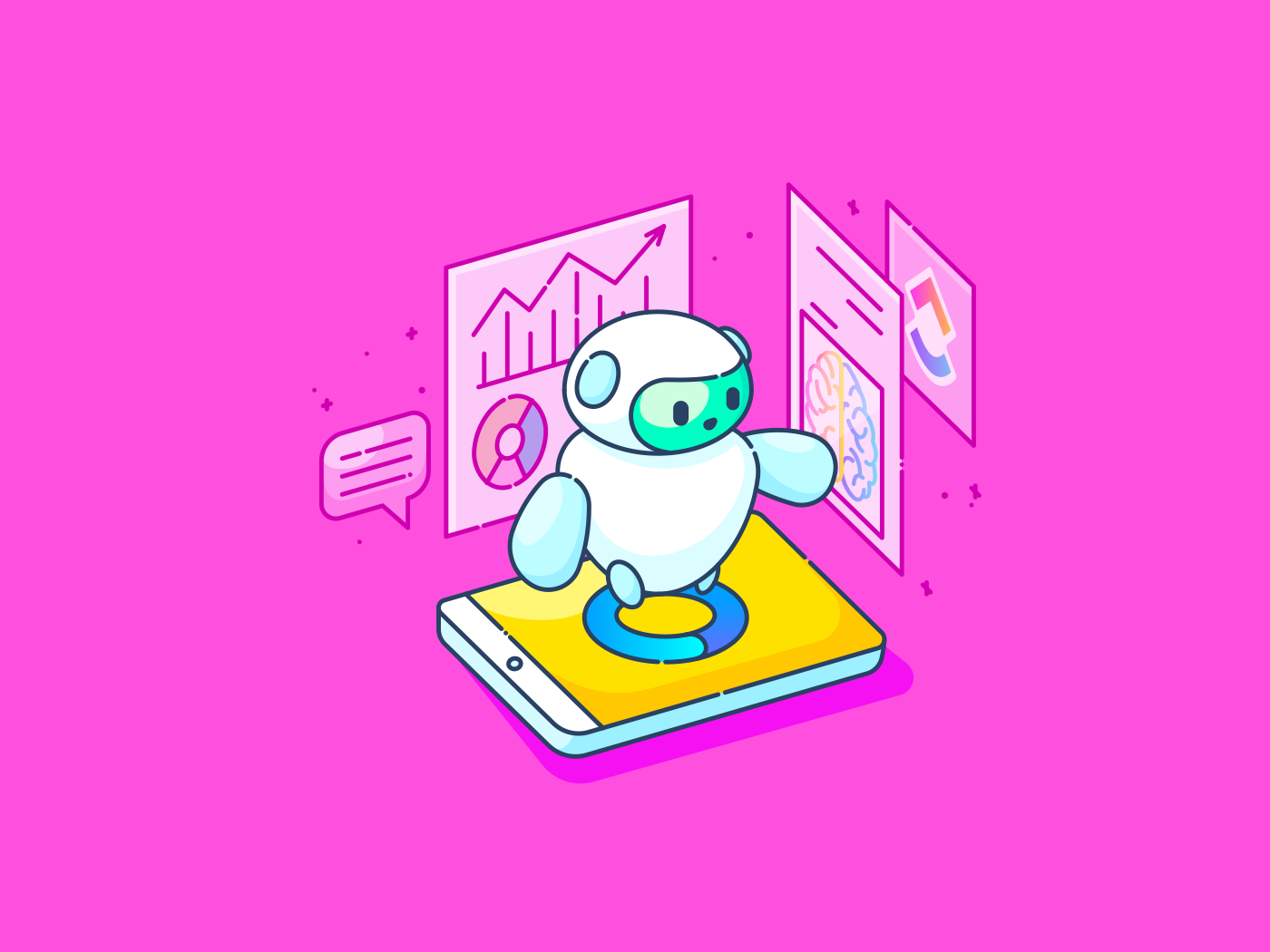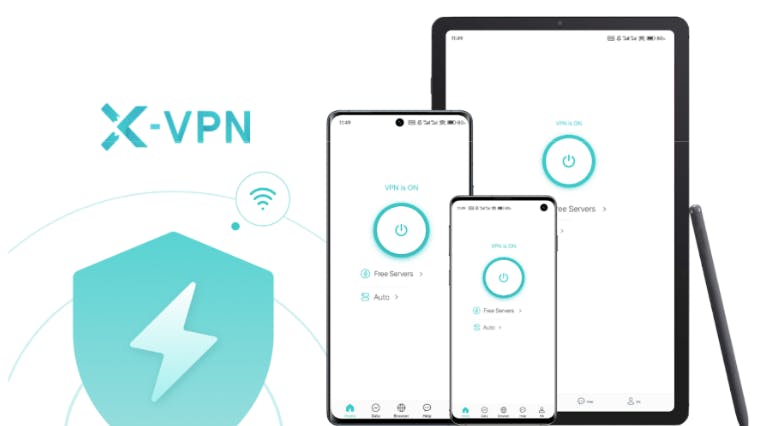A Capgemini report shows that 50% of US companies now use Generative AI for their marketing projects. While these tools are evolving, they can’t streamline multi-stage workflows or handle large-scale data without frequent human input.
But what if you could gain that competitive advantage today? What if there’s a way to automate complex processes right now?
Enter AI Agents—the next stage of AI implementation for businesses!
Knowing how to build an AI agent is crucial in the long run. Once you know how to build a custom agent, you can automate tasks (like customer service or market analysis) with little human intervention and reduce overall costs.
In this blog, we’ll answer everything about AI agents, from what they are to how you can develop one. Stick around to the end—we’ll reveal an AI agent that’s efficient and seamless for your task and project management needs!
⏰60-Second Summary
- AI agents are autonomous AI tools with decision-making capability
- They can interact with humans and tech tools in their environment
- AI agents are already being used in e-commerce, healthcare, business process automation, and cloud computing industries
- You can build a custom AI agent with data scientists, UX designers, machine learning, and software development experts—or simply use the no-code builder in
- If you use for project management, you’ll already have Prebuilt AI Agents at your disposal, plus the tools to create Custom Agents tailored to your work
Let’s tackle the basics first.
What is An AI Agent?
If you’ve ever chatted with an AI assistant on a website, you’ve already interacted with a basic AI agent. The most common places to find them today are on companies’ support pages, answering customer queries, creating support tickets, or arranging calls with live support agents.
However, an AI agent’s capabilities are not limited to managing customer support alone. It can do a lot more, as you’ll see below.
Definition of an AI agent
An AI agent is an autonomous program that performs pre-defined functions with minimal human intervention. It can recognize and interact with different actors and elements in its environment to help you achieve your goals.
For instance, if you want to send someone an email, an AI agent can take the necessary inputs from you, such as the recipient’s email address, email topic, file attachments, etc. It then interacts with your email client to draft the email on its own using generative AI.
Once done, it shows you a preview of the email so you can change anything if required and send it once the changes are made.
Key characteristics of AI agents
Here’s what you need to know about AI agents in a nutshell:
- Minimal human input requirement
- Continuous learning and improvement
- Context awareness and ability to interact with their environment
- Ability to read, extract, and modify data from external sources
- Understanding of human language and behavior
- Ability to make decisions based on their training and learning
Types of AI agents
You can categorize AI agents based on various elements (i.e., design vs. functionality). Here, we’ll categorize them based on functionality, which brings us to two major types of agents that are seen prominently across organizations nowadays:
- Autonomous AI agents: These agents are usually customer-facing and have a high level of autonomous decision-making capability. They manage customer queries without requiring human intervention from your employees.
- Assistive AI agents: These are internal AI-powered apps that assist your employees in completing complex tasks. Since they are internal, they may or may not have a graphical UI, depending on your preferences.
How to Build An AI Agent
Building AI agents isn’t difficult but requires a structured approach and proper planning.
🧠 Fun Fact: With ’s Autopilot Agents, you don’t need to build AI agents from scratch with code or complex models—unless you want to. You can start with Prebuilt Agents for quick wins (like automating daily reports or chat responses for FAQs) or create Custom Agents using natural language prompts, triggers, and actions—no ML expertise required.
Here’s a quick video setup guide:
But whether you’re building an AI agent in or elsewhere, the core methodology stays the same. Here are eight steps you must follow when you build custom AI agents for your business requirements:
Step 1: Define the purpose of your agent
Before you start building your own AI agent, you must clearly define what you want to achieve with it. And we’re talking about formal documentation.
Sure, you may have a rough idea of what you want the AI agent to do, but to ensure that nothing is missed, you must document all the functions and capabilities you want in it.
Additionally, it creates a central document to which your development team can refer when they want to understand the agent’s environment and expectations.
Step 2: Build a team
The next step (and it’s a crucial one) is to put together your team to build the AI agent. Even if you’re a software developer, DO NOT attempt to build AI agents all by yourself. That’s because building a robust one requires expertise from different fields, including:
- Data science and analysis
- Machine Learning (ML)
- UI design
- Software development
Until you engage professionals from all these fields, you might end up building a flawed AI agent. Instead, assemble a team of experts first.
💡 Pro Tip: In , you won’t need ML engineers for Autopilot Agents, but it’s smart to include:
- The subject matter expert (to define what the agent should know)
- The workflow owner (to outline where the agent will act)
- The writer/strategist (to decide how the agent communicates)
With Brain, ’s native AI assistant, your team can brainstorm ideas and refine agent instructions to build one faster.

Step 3: Identify your tech stack
Once you’ve put your team together, you should discuss and decide on the technologies that will serve as the platform for your AI agent. This includes:
- Programming language (Java, Python, etc.)
- Hosting environment
- Natural Language Processing (NLP) libraries (Gensim, NLTK, etc.)
- Data analysis libraries (Plotly, SciPy, NumPy, etc.)
- ML model (i.e. GPT, BERT, Llama, etc.)
- Technologies based on specific capabilities (i.e., computer vision, speech recognition, robotic process automation, etc.)
You should also leave some room for other libraries and frameworks that might be required.
Once you identify and select all these elements for your AI agent’s tech stack, you’ll have a strong foundation to build on.
🔮 But, what if we told you that in , you can skip this headache. Your “stack” becomes:
- Triggers (e.g., status change, chat message)
- Instructions (custom prompts)
- Knowledge (Docs, tasks, chat history)
- Actions (like replying, summarizing, assigning)
You can even connect external tools like Slack or GitHub via integrations and include their data in your agent’s Knowledge sources.
Step 4: Make your design considerations
Besides identifying the tech stack you want to use, there are design considerations that you should take into account before developing AI agents. They include:
1. Architecture
There are two approaches you can take for the architecture of your custom AI agent—modular and concurrent. In modular architecture, each part of the agent is designed sequentially and separately before being put together to finalize the agent. Concurrent architecture, on the other hand, is one in which all parts are trained and built at the same time.
2. User interface and experience (UI/UX)
If you want your AI agent to have a public-facing user interface, then you should also consider the elements you want to include in UI/UX. This includes your branding, a mascot, a name you want to give to it, etc.
3. Data handling
How your custom AI agent receives and works with relevant data is another crucial consideration you should make. This means clearly defining the entire data flow from start to end, including:
- Data/information to be received from the user
- Data/information to be extracted from your server
- Functions to be performed on extracted data
- Delivering the end result to the user
Each step in the data handling process should be laid out in detail.
4. Feedback mechanism
Consider including a feedback mechanism in your AI agent system. Whether it’s a survey, a rating method, or a simple like/dislike button. It’s essential to receive feedback about the agent from users to improve the tool continuously.
Step 5: Label and clean your training data
There are three kinds of data sources you can use to prepare and train your agent, depending on who will be its end users:
- Operational data of your organization
- External data you received or acquired from third-party sources
- User-generated data that was generated by your customers/users
Regardless of whatever raw data you choose to train your model on, it must be labeled and cleaned before training. What’s labeling and cleaning? Well, here’s a brief overview:
- Labeling: This refers to the manual categorization, tagging, and labeling of data by humans to make it understandable for your AI agent. It’s done, so the AI model used in your agent can build connections between data points and correctly recognize what each type of data represents.
- Cleaning: This refers to removing any anomalies from your dataset, such as empty rows, misrepresented or missing values, errors, etc. Removing them eliminates the possibility of your AI agent being trained on flawed data.
💡Pro Tip: Tools like SuperAnnotate, DataLoop, and Encord help you with both these steps.
Step 6: Build and train your agent
Now, you can start building and training your AI agent. Start by setting up your training environment—install all necessary ML libraries and frameworks, start the training tools, and load your data.
⚠️ IMPORTANT: Don’t load all your data at once. Divide it into two subsets and load only one. Keep the other set for testing purposes.
Once you have loaded your data, initialize the ML model you selected in step three. Set the training parameters (they can vary depending on your chosen model, so it’s difficult to go into specifics here), and start the training process.
Track metrics like loss and accuracy during the training process to get an idea of how well the model is learning. If it’s not learning well, tweak the training parameters.
At the same time, UI developers should design and build the UX of your AI agent.


📌 In , use the Custom Agent builder:
- Set a trigger (e.g., “every Monday” or “when a task is overdue”)
- Add conditions (“only if priority is high”)
- Write natural language instructions (“Summarize the top 5 updates”)
- Choose tools (e.g., reply in thread, create task, assign user)
When adapting, you don’t need to retrain anything—just tweak instructions or knowledge sources and test again. Fast iteration FTW.
Step 7: Test the agent
Once the training process is complete, it’s time to test your model. This is where the other half of your dataset that you reserved for testing purposes (Step 6) will come into the picture.
Start your AI agent, run it through the queries of your testing dataset, and analyze the results. Observe how accurately it performed the desired function on each data point in your dataset. Also, observe how long it took to perform those actions.
If the agent works as intended, there are three more types of tests you must perform on it. These are:
- Unit tests: Test each module or unit of your AI agent independently to ensure that they function properly
- User tests: Invite some target users of the agent to try it under your observation so you can analyze how users might use it and how accurately it works in each scenario
- A/B tests: Compare two versions of the agent side-by-side to see which one does the job better
Each of these tests will optimize your AI agent’s performance and ensure that it performs well in real-world scenarios. However, if it doesn’t perform well during the tests, you may have to retrain the agent with adjusted parameters or a bigger dataset.
Step 8: Deploy and monitor the agent
Finally, once your AI agent is working as intended, it’s time to deploy it. Integrate it with your existing systems and deploy it on your website or app. Monitor how accurately and quickly it responds to user queries by analyzing user logs and feedback that comes through the built-in feedback mechanism of your AI agent.
If there’s any room for improvement, roll out a new version of the agent by addressing the issues flagged by users.
🌰 In a nutshell: Whether you’re writing code or using ’s no-code Autopilot Agents, building a great AI agent still requires thoughtful planning, design, and iteration.
The difference? In , most of the heavy lifting—model hosting, prompt optimization, integration—is handled for you. So you can focus on what really matters: designing intelligent workflows that actually save time.
📮 Insight: Only 10% of our survey respondents regularly use automation tools and actively seek new opportunities to automate.
This highlights a major untapped lever for productivity — most teams are still relying on manual work that could be streamlined or eliminated.
’s AI Agents make it easy to build automated workflows, even if you’ve never used automation before. With plug-and-play templates and natural language-based commands, automating tasks becomes accessible to everyone in the team!
💫 Real Results: QubicaAMF cut reporting time by 40% using ’s dynamic dashboards and automated charts—transforming hours of manual work into real-time insights.
Implementation and Use Cases of Custom AI Agents
The use cases of AI (particularly its agents) are immense in each industry. There are four major areas where they are currently leaving their mark.
1. AI agents in e-commerce: AI consultants and customer service agents
The AI agents in e-commerce companies generally aim to achieve two key objectives:
- Predicting demand fluctuations: By analyzing historical sales data and market trends, the e-commerce AI agents predict demand fluctuations and help their businesses stay ahead of the curve
- Handling customer support tasks: E-commerce AI agents also analyze customer interactions for accurate resolutions
Example: Shein’s Virtual Assistant is an excellent example of using an AI agent to assess changing market trends. In fact, it lists up to 600,000 items based on consumer needs, all for a global market!
2. AI agents in healthcare: predictive maintenance and virtual assistants
AI agents can help healthcare companies prevent equipment failures by continuously monitoring and analyzing the health of medical devices. This increases equipment life and also alerts the organization when it’s time to replace the devices.
Additionally, AI-powered virtual assistants and chatbots are helping patients with follow-up reminders and appointment scheduling. They can even analyze medical data for treatment suggestions and help doctors with a diagnosis. See how. 👇
Example: IBM Watson Oncology acts as a proactive AI agent in the field of cancer treatment. Designed to assist oncologists in making informed decisions, it analyzes patient data, extensive medical literature, and relevant clinical trials to generate evidence-based treatment recommendations.
While ultimately requiring physician input, Watson Oncology proactively presents potential treatment options and highlights pertinent research findings, thereby actively contributing to the decision-making process by providing crucial information.
3. AI agents for business process automation: recommender systems and robotic process automation
Businesses prefer using AI agents for task automation when working with Robotic Process Automation (RPA) tools. Examples include:
- Automatic claim settlement by insurance companies using computer vision and data analytics
- Fraud detection and automated blocking of fraudulent transactions in financial companies by analyzing historical data
- AI and ML-driven automated document classification based on previous data
Example: Fukoku Mutual Life, an insurance company in Japan, uses AI agents to process claims. With AI, it can access medical insurance and automatically calculate payouts. This led to the company saving almost $1 million in costs and increased their employees’ productivity by 30%.
4. AI agents in cloud computing and automation
AI Agents can help cloud computing and automation companies with resource planning, security monitoring, and customer support activities. They do this by:
- Predicting computing power requirements
- Analyzing and monitoring suspicious user activity
- Understanding customer queries using NLP before responding with answers from an AI knowledge base
Example: Amazon Web Services (AWS) is a standout instance of using AI agents to predict computing power requirements. Using historical data, its AI systems efficiently allocate resources and save costs. This ensures that even with usage spikes, AWS’s systems don’t face any downtimes.
The AI Agent for Your Project Management
Remember when we said we’d reveal an AI agent at the end? We revealed it already (if you were paying attention! 🤩)
Well, here’s the best part: you don’t have to build it from scratch.
If you’re looking for agentic AI that actually boosts your productivity in real-world project management—this is your shortcut to a competitive edge.
Meet Autopilot Agents—your customizable, no-code AI teammates that take action across your workspace to save you time, close the gaps, and move work forward.
🧠 Not just suggestions. Actual actions
’s Autopilot Agents don’t just analyze—they act. Whether you use a Prebuilt Agent to send daily summaries or build a Custom Agent to escalate blocked tasks, these agents:
- Monitor your workspace for specific events
- Follow natural language instructions to decide what to do
- Take action automatically—post in Chat, update tasks, assign teammates, and more
You define the triggers, knowledge, instructions, and tools. The agent handles the rest.
💬 AI-powered collaboration—now context-aware
While Chat helps teams communicate in real time, Autopilot Agents make Chat actionable. Agents can monitor your conversations, answer questions using workspace knowledge, and even create tasks or reply with summaries.


📌 Examples:
- The Auto-Answers Agent replies to team questions by pulling directly from your tasks, Docs, and other workspace knowledge
- A custom agent can monitor a product feedback thread and auto-tag the product team when specific keywords are mentioned
💡 Pro Tip: In Chat, use the “Catch me up” feature powered by Brain to get instant summaries, then let an Autopilot Agent follow up with action items.
🔐 Built for real work, with privacy in mind
’s Autopilot Agents work within your workspace boundaries. You control:
- What data the agent can access (e.g., only certain Lists or Docs)
- Who it interacts with
- When and how it takes action
Your team’s knowledge stays secure—and your agents stay helpful!
Make Work Effortless with ’s AI Agents
Business processes—like task management or customer service—will most likely be handled by advanced AI agents soon. It won’t be long before you see enterprises implement custom agents for their routine tasks and workflows.
Want to get ahead of the competition but don’t want to spend resources on building custom AI agents just yet?
Unlike generic AI bots, ’s Autopilot Agents are tightly woven into your workflows. That means:
- Less switching between tools
- No need to build complex prompts from scratch
- More confidence that the right work is happening at the right time
And with Brain as the intelligence layer powering AI writing, summarization, and search, you can supercharge how agents communicate and learn from your workspace content.
If you’re ready to maximize your business efficiency, sign up for for free!


Everything you need to stay organized and get work done.












